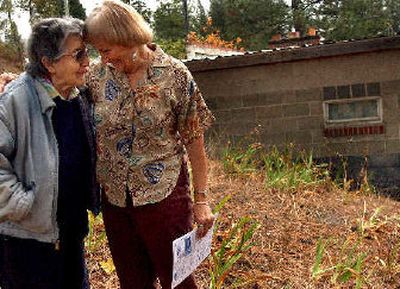Gas prices burn meal program

Esther Travis looks forward to her thrice-weekly visits from Meals on Wheels volunteers.
The 84-year-old retired schoolteacher doesn’t drive and rarely leaves the Coeur d’Alene home her husband built half a century ago. She relies on the meals cooked at the Lake City Senior Center and visibly enjoys the folks who bring them.
“This way every meal is a delight,” Travis said Monday after receiving a warm tray of German sausage, sauerkraut, corn, potatoes and bread and a frozen meal to eat later.
She also got a warm greeting from Meals on Wheels volunteer Helen Vlahos and an arm to lean on as she went back into her house.
Travis is among hundreds of North Idaho shut-ins who stay relatively independent and well-fed because of the network of local senior centers that deliver their meals.
But with the climbing cost of gasoline, some Panhandle senior centers are thinking of cutting back their deliveries.
The Sandpoint Area Senior Center, for instance, may have to switch from daily trips to weekly ones, delivering precooked meals for the whole week at one time.
The Sandpoint center delivers more than 1,500 meals a month, said manager Norma Jean White.
Most deliveries are made in the senior center’s vans, and the cost to fill them with gas has increased about $30 in the past month, she said. Add that to the increasing cost of food and expected increases in heating bills, and money is becoming a growing concern for senior programs everywhere.
“It puts us in the hole more than usual,” said Linda Remmick, manager of the Rathdrum Senior Center. Volunteer drivers there have the choice of using their own car or the center’s Dodge van, which gets about 18 miles per gallon, she said.
“You have to warm it up forever, and that burns gas,” Remmick said.
Cutting back on deliveries is not a decision to take lightly, White said.
“A lot of our clients, that’s the only person they see, is the driver,” she said. “Keeping track of them is part of what we do, making sure they’re OK.”
At one stop Monday, Vlahos and her husband, Gus, couldn’t deliver a meal because the home was locked. They peeked through the window and saw the back door was open, but they couldn’t get through the locked gates to the back door.
A dachshund, which they were also instructed to feed, stood on the back of the sofa inside and barked at the couple through the window.
“I’m sorry, doggie,” Helen Vlahos said, as she got back in her van. As soon as she got back to the senior center, Vlahos reported the problem and a phone call to the house revealed the woman was OK. The meals were delivered later by the center’s Meals on Wheels coordinator.
Lake City Senior Center clients are lucky. Center director Tom Moore said gas is less of a concern than utility and food costs, so he’s not planning to reduce the number of Meals on Wheels trips.
The center serves about 48,000 meals a year and budgets about $70,000 for food. But food costs are up about 10 percent over last year, he said.
“That 10 percent ends up being a substantial amount of money,” he said. “When there’s a spike in gas prices, we notice it not so much in gas. Our gas reimbursement for the year is normally about $5,000, and a lot of our drivers turn that back in.”
The increase in food prices can be directly tied to the increase in fuel prices, said state economist Mike Ferguson. Every aspect of food production involves fuel, from fertilizing the fields to transporting the commodities to the grocery aisles.
“We’ve seen fuel costs up for going on a year now,” Ferguson said. “There’s been plenty of time for that to work its way through the system.”
North Idaho Aging and Adults Services director Pearl Bouchard said she’s hearing from many senior centers the same concerns regarding gas prices, food prices and increasing utility costs for the centers themselves.
“When food prices are going up, it affects their budgets directly,” she said. “They have to start making some hard decisions.”